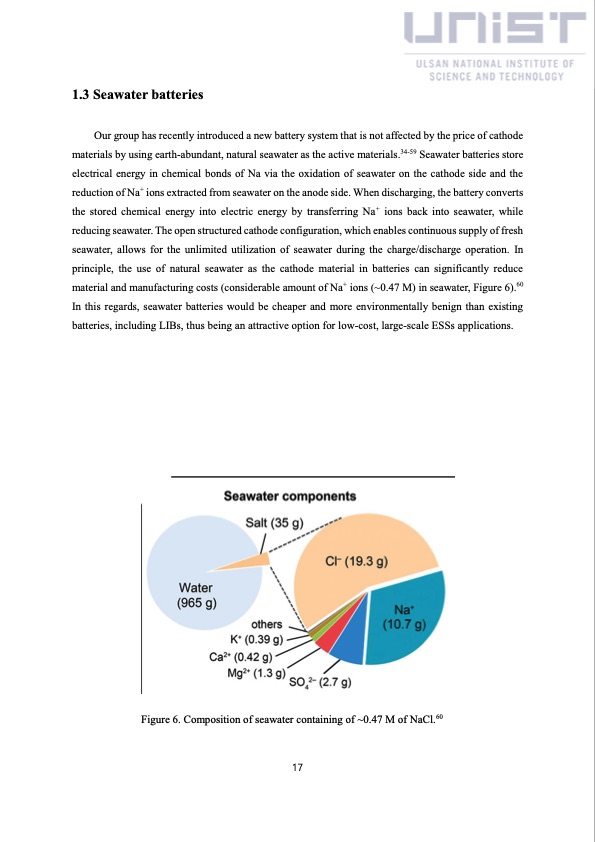
PDF Publication Title:
Text from PDF Page: 022
1.3 Seawater batteries Our group has recently introduced a new battery system that is not affected by the price of cathode materials by using earth-abundant, natural seawater as the active materials.34-59 Seawater batteries store electrical energy in chemical bonds of Na via the oxidation of seawater on the cathode side and the reduction of Na+ ions extracted from seawater on the anode side. When discharging, the battery converts the stored chemical energy into electric energy by transferring Na+ ions back into seawater, while reducing seawater. The open structured cathode configuration, which enables continuous supply of fresh seawater, allows for the unlimited utilization of seawater during the charge/discharge operation. In principle, the use of natural seawater as the cathode material in batteries can significantly reduce material and manufacturing costs (considerable amount of Na+ ions (~0.47 M) in seawater, Figure 6).60 In this regards, seawater batteries would be cheaper and more environmentally benign than existing batteries, including LIBs, thus being an attractive option for low-cost, large-scale ESSs applications. Figure 6. Composition of seawater containing of ~0.47 M of NaCl.60 17PDF Image | China solar seawater battery

PDF Search Title:
China solar seawater batteryOriginal File Name Searched:
solar-seawater.pdfDIY PDF Search: Google It | Yahoo | Bing
Product and Development Focus for Salgenx
Redox Flow Battery Technology: With the advent of the new USA tax credits for producing and selling batteries ($35/kW) we are focussing on a simple flow battery using shipping containers as the modular electrolyte storage units with tax credits up to $140,000 per system. Our main focus is on the salt battery. This battery can be used for both thermal and electrical storage applications. We call it the Cogeneration Battery or Cogen Battery. One project is converting salt (brine) based water conditioners to simultaneously produce power. In addition, there are many opportunities to extract Lithium from brine (salt lakes, groundwater, and producer water).Salt water or brine are huge sources for lithium. Most of the worlds lithium is acquired from a brine source. It's even in seawater in a low concentration. Brine is also a byproduct of huge powerplants, which can now use that as an electrolyte and a huge flow battery (which allows storage at the source).We welcome any business and equipment inquiries, as well as licensing our flow battery manufacturing.| CONTACT TEL: 608-238-6001 Email: greg@salgenx.com | RSS | AMP |